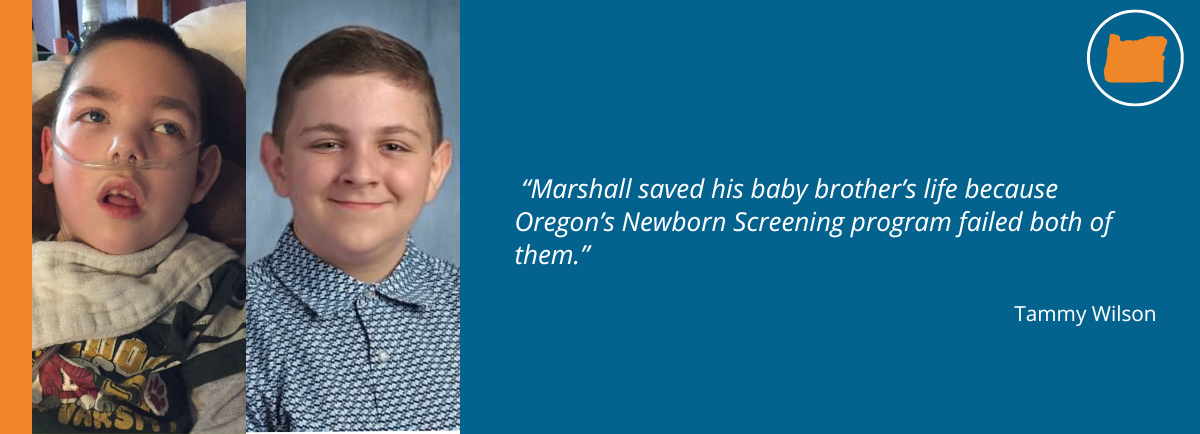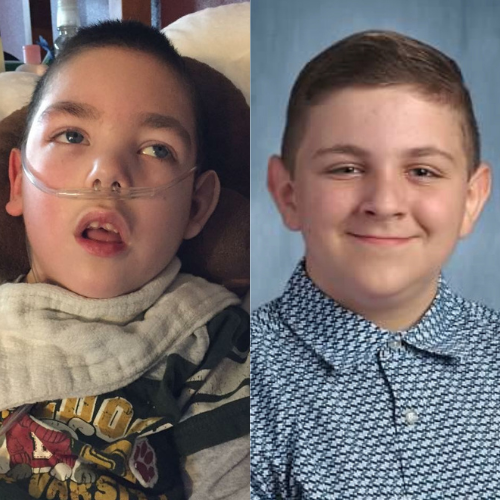DOWNLOAD STATE FACT SHEET AS PDF

In 2020, there were 39,820 live births in Oregon2 There are 42 conditions on the Oregon Newborn Screening Panel3
All babies in the United States are screened for several conditions shortly after birth. Approximately 24-48 hours after a baby is born in the United States, the heel is pricked by a nurse to collect a small blood sample. Afterward, the nurse puts a series of blood drops onto a filter paper to create several “dried blood spots.” Next, the newborn screening card is sent to the state laboratory for analysis. Oregon is not screening for Krabbe Disease.
What is Krabbe Disease?
Krabbe disease (pronounced krab A), is a rare genetic disorder, also known as globoid cell leukodystrophy. In the United States, Krabbe disease has been reported to affect approximately 1 in 100,000 individuals. Infantile Krabbe disease is the most common and severe form causing infants to lose the ability to eat, extreme irritability, inability to sit up, grasp objects, blindness, and seizures. Sadly, infants die within the first 2-3 years of life in states that do not test for Krabbe disease. We invite you to learn more about Understanding Krabbe Disease.
Why Screen for Krabbe Disease?
Krabbe disease is a severe neurodegenerative and rapidly progressing condition requiring immediate treatment for the most severe forms. The medical issues and symptoms of Krabbe disease are very significant and life-impacting. A delayed diagnosis, especially in the most severe forms, equates to palliative and supportive care as the only means of treatment until premature death.
Krabbe Disease Hero: Marshall & Michael Wilson

See all our Krabbe Disease Heroes.
When Marshall Wilson was around a year old, his parents, David and Tammy, began to notice that he was regressing in milestones and expressed concerns to his pediatrician. They noted that in a matter of a week, he had lost the ability to move his legs and take steps. The doctor ordered some tests and the diagnostic odyssey began. A few weeks later, they noticed that his head was tilting slightly; this development prompted the pediatrician to send them to a neurologist at their local children’s hospital. They continued evaluating Marshall and running tests, all while Marshall was losing milestones each day. During all of this, Tammy was pregnant with their fourth child and her due date was drawing near. Once Marshall’s MRI was scheduled, she asked to be induced, since she was full-term, so that she didn’t miss the MRI; Michael was born soon after.
After receiving a tentative diagnosis of Metachromatic Leukodystrophy (MLD), they were sent to a geneticist for further testing. Tammy was at work when the fateful phone call was received: the testing revealed that Marshall had Late Onset Krabbe Disease and they were advised to have their newborn son, Michael, tested as well – advice that would turn out to be incredibly valuable. She immediately began researching Krabbe Disease and learned that seventeen-month-old Marshall might only have six months to live.
One month later, their journey would become even more complicated when it was discovered that two-month-old Michael also had Krabbe Disease. The news was yet again delivered over the phone, but this time Tammy was at home with her family. She grabbed David’s arm and led him to the garage to tell him the devastating news. She collapsed on the floor, weeping and devastated, thinking “how is it that my two youngest children have death sentences at such a young age?”
Thankfully, there were options for Michael and the Wilsons pursued treatment immediately. He underwent a stem-cell transplant two months later. Navigating Marshall’s declining health while also caring for Michael during the transplant was not easy. Michael spent a great deal of time in the hospital but remained a happy baby, and his favorite toy was a musical rattle that he would push against his mouth to make noise.
The Wilsons made sure that Marshall had the best possible life with as many adventures as possible. David even put lights on his wheelchair to make it unique. Marshall loved everything about life and was a “happy old soul” despite his challenges. He loved to play in the water the most. Marshall proved the doctors wrong and lived to be nearly seven years old. Michael is currently thirteen years old and shows no signs of Krabbe Disease thanks to timely treatment.
Resources
- The Leukodystrophy Newborn Screening Action Network is dedicated to advancing newborn screening for leukodystrophies and lysosomal storage disorders, supporting newly-diagnosed families, and ensuring collaboration between all stakeholders. Learn more at https://ldnbs.org/.
- CDC offers funding and assistance through the Newborn Screening Quality Assurance Program (NSQAP). More information can be found at https://www.cdc.gov/labstandards/nsqap.html.
- Baby’s First Test provides funding opportunities through grants. Learn more at https://www.babysfirsttest.org/newborn-screening/funding-opportunities.
- American Public Health Laboratories NewSTEPS program provides data, technical assistance, and training. Details at https://www.newsteps.org/.
- KrabbeConnect offers patient support services to help families navigate the burden of Krabbe disease. Learn more at https://krabbeconnect.org/.
- Hunter’s Hope Foundation is a non-profit organization committed to giving hope through education, awareness, research, and family care for all leukodystrophies. Learn more at https://www.huntershope.org/.
Citations
- Wenger DA. Krabbe Disease. 2000 Jun 19 [Updated 2011 Mar 31]. In: Pagon RA, Adam MP, Ardinger HH, et al., editors. GeneReviews® [Internet]. Seattle (WA): University of Washington, Seattle; 1993-2017.
- “Fertility Rate: Oregon, 2010-2020.” March of Dimes | PeriStats, https://www.marchofdimes.org/peristats/data?reg=99&top=2&stop=1&lev=1&slev=4&obj=1&sreg=34. Accessed 13 August 2023.
- “Oregon| Baby’s First Test | Newborn Screening | Baby Health.” Babysfirsttest.org, 2015, https://www.babysfirsttest.org/newborn-screening/states/Oregon. Accessed 13 August 2023.
All information in this fact sheet is based on data available before August 13, 2023.


